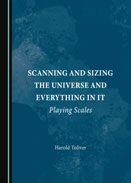
 |
Scanning and Sizing the Universe and Everything in It: Playing Scales
by Harold Toliver
Cambridge Scholars Publishing
People have long tried to make sense of the world in which they live, either with notions of religion and mysticism or scientific study. A common trapping of either approach is to anthropomorphize our world as if all things in it must make sense in the context of human existence and experience. Yet, as we use technology and new advances to extend our observation to the vast nature of space and the minuscule details of the atomic and subatomic levels, many people manage to make this same error. Rather than taking stock of the very small set of circumstances that can sustain human life, many try to contextualize these previously unknown, unglimpsed realms in a way that only benefits us as humans to understand.
Drawing from centuries of discourse between naturalists or scientists and those who feel that there are domains we are not meant to look into, this book discusses a plethora of the day’s biggest questions. By offering the scientific advances that put these strange frontiers into perspective, it becomes simple to see that trying to bring an issue of scale far beyond what human life on Earth has the context or the skills for out of its normal perspective leads to skewed and fallible results. Instead, we can find the value of this knowledge massively edifying without making it about us, gaining more historical perspective about this planet, everything on it, and what needs to be done to ensure its prolonged existence in relative comfort and safety.
The cutting edge of scientific research can be found in understanding how the tiniest elements of large celestial bodies operate, neither of which can be properly found and studied in a natural environment on Earth. Similarly, the measurements that most people are equipped to think in are totally unsuitable for this task without the use of ridiculous comparisons or lengthy exponents. The author’s point of detaching that humanizing mindset from questions concerning inhuman materials and subjects is best typified as simply using the wrong tool for the job. A wealth of texts from great thinkers both within and outside of the scientific discipline are quoted, showing what kind of resistance might be found in taking such an approach, but also in the merits of removing this kind of self-centered motivation from the equation.
Beautifully phrased, fully contextualized, and diligently sourced, this material manages to make a quandary that, by its own admission, is hard to visualize and grasp into something that presents itself without much confusion. Whether a seasoned academic or someone looking to broaden their perspective a little bit, the reader will find a veritable rabbit hole of research topics and questions they didn’t even know they were curious about. The structure of each chapter begins by summarizing the argument the author is prepared to lay forth so that there is an immediate understanding of what is being discussed, and each following page and subsection unravels methodically, keeping things in a logical train of thought that keeps things fascinating and reined in just enough to keep from losing the point. Though we may not be able to detect these objects, components, or phenomena with the naked eye or any of our natural senses, the importance of continuing to study and understand them becomes all too apparent after just a few pages of reading this fascinating and thought-provoking book.
RECOMMENDED by the US Review